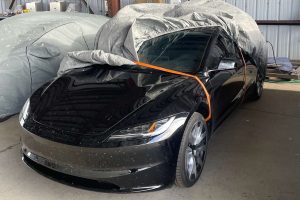Tesla’s impressive third-quarter delivery performance overshadowed the automotive industry’s ongoing struggle with the semiconductor chip shortage. Among all of the world’s automakers, Tesla has been basically the only car company to avert the crisis as it has not had any overwhelmingly public stoppages in vehicle production. Morgan Stanley’s new investor note, drafted by lead analyst Adam Jonas, examines Tesla’s ability to avoid detrimental production stoppages, which effectively helped the company capture its best quarter in company history.
Jonas titles Morgan Stanley’s most recent investor note, “How Did Tesla Find Chips?” In all honesty, this riddle was solved during the Q2 2021 Earnings Call, where Tesla stated in its Shareholder Deck that it used a combination of in-house microcontrollers to avoid any major catastrophes in the manufacturing of its vehicles. The company wrote:
“Our team has demonstrated an unparalleled ability to react quickly and mitigate disruptions to manufacturing caused by semiconductor shortages. Our electrical and firmware engineering teams remain hard at work designing, developing and validating 19 new variants of controllers in response to ongoing semiconductor shortages.”
Jonas broke down Tesla’s ability to break through the parts shortages in four categories: Vertical Integration, Sophistication, Negotiation, and Scale.
VERTICAL INTEGRATION
It is no secret Tesla is amongst the most highly vertically integrated companies in the world, especially in terms of the automotive sector. It controls and maintains many of its own parts, including its vehicle seats. However, the company’s ownership of its retail channel is just a huge advantage in terms of the company’s ability to navigate through the global parts shortages. Customers are not paying astronomical prices for replacement parts, and owners are not tasked with paying increased rates for vehicle service.
SOPHISTICATION
Jonas writes that Tesla’s in-house development of its vehicles also comes down to the company’s ability to install the best tech, including processors into its vehicles. Tesla has a reputation for developing the most high-tech vehicles in the market. It’s remarkably true.
NEGOTIATION
While Tesla’s vehicles are amongst the most vertically integrated on the market, the company still maintains relationships with suppliers for the parts it doesn’t make on its own. Its ability to “further in-source technology keeps suppliers on its toes,” while increasing collaboration at a rate that far exceeds other OEMs.
SCALE
While Tesla is growing at a very fast rate on a quarter-over-quarter basis, the company is smaller than other OEMs. Jonas writes:
“At the same time, many suppliers believe Tesla is on its way to becoming a dominant OEM with a multiple of the annual volume that it has today. Despite its modest size, most suppliers consider Tesla a ‘strategic’ customer.
It’s no secret that Tesla’s over 241,000 vehicle deliveries provide an even further bullish outlook on the company’s stock. How it managed to evade the chip shortage comes down to preparation and scalability. While its order forms are not as extensive as other OEMs’, it’s still growing tremendously, outpacing the predictions of even the most robust and informed analysts on Wall Street.





